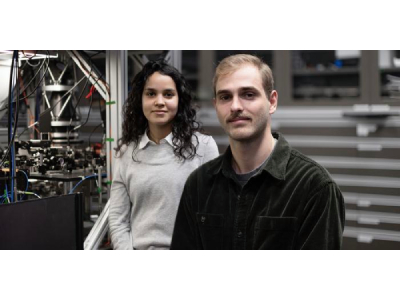
Lead authors Vanessa Olaya Agudelo and Dr Christophe Valahu. Credit: Stefanie Zingsheim/University of Sydney
Researchers at the University of Sydney have for the first time, utilized a quantum computer to observe a simulated chemical reaction that was slowed down by a factor of over 100 billion times. Further understanding the basic mechanics of a chemical reaction will have tremendous effects throughout numerous industries and will certainly lead to improvements in research and technology.
By slowing down the reaction researchers were able to observe a conical intersection, a common geometric structure in chemistry that is vital for photo-chemical processes such as photosynthesis. Scientists have tried to observe phenomena such as this since as early as the 1950’s however due to the extremely rapid timescale involved, that has not been possible until now.
“In nature, the whole process is over within femtoseconds,” said Olaya Agudelo from the School of Chemistry. “That’s a billionth of a millionth – or one quadrillionth – of a second. Using our quantum computer, we built a system that allowed us to slow down the chemical dynamics from femtoseconds to milliseconds. This allowed us to make meaningful observations and measurements. This has never been done before.”
In the study, published in Nature Chemistry, the researchers developed an experiment using a trapped-ion quantum computer, which allowed them to map the process and slow it down by a factor of 100 billion.
“It is by understanding these basic processes inside and between molecules that we can open up a new world of possibilities in materials science, drug design, or solar energy harvesting,” said joint lead researcher Vanessa Olaya Agudelo. “It could also help improve other processes that rely on molecules interacting with light, such as how smog is created or how the ozone layer is damaged.”
The findings revealed the never-before-seen conical intersections in photochemistry. “Using our quantum computer, we built a system that allowed us to slow down the chemical dynamics from femtoseconds to milliseconds. This allowed us to make meaningful observations and measurements,” said Joint lead author Dr Christophe Valahu.